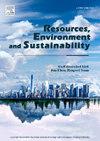基于气候变化和土壤肥力因子的耦合机器学习模型模拟新疆棉花适宜性评价
IF 12.4
Q1 ENVIRONMENTAL SCIENCES
引用次数: 0
摘要
棉花是世界上种植最广泛的纤维作物,在新疆具有重要意义。然而,不适宜的种植环境会阻碍农民的收入,并导致农业资源的大量浪费。本研究探讨了新疆棉花种植区在减少农业投入和污染方面的适宜性。目标是通过考虑气候变化和土壤肥力来促进可持续农业发展,这两个因素在以前的研究中经常被忽视。通过对新疆气候变化趋势的分析,利用机器学习-迁移成分分析,建立了全氮(TN)和土壤有机碳(SOC)指标的可迁移耦合模型,得到了考虑气候和土壤肥力因素的棉花适宜性分区。新疆累计气温和降雨量总体上升,其中南疆增幅最大,累计气温上升4.02%,累计降雨量上升16.26%。随机森林模型(RF)对土壤肥力指标的预测效果优于多元线性回归(MLR)和支持向量机(SVM) (TN: R2=0.80, SOC: R2=0.77)。RF-TCA耦合模型增强了自适应能力,在TN预测方面优于SOC。基于气象和土壤资料的新疆棉花适宜性区划表明,北疆适宜种植面积向北转移,南疆适宜种植面积继续保持较大数量。值得注意的是,随着时间的推移,两个地区在适宜性方面的差距一直在缩小。该研究为优化棉花种植区位、提高资源利用效率、促进新疆可持续发展提供了有价值的见解。本文章由计算机程序翻译,如有差异,请以英文原文为准。

Evaluation of cotton planting suitability in Xinjiang based on climate change and soil fertility factors simulated by coupled machine learning model
Cotton is the world’s most widely cultivated fiber crop and holds great significance in Xinjiang. However, unsuitable planting environments can hinder farmer income and result in a substantial waste of agricultural resources.This study explores suitability of cotton planting areas in Xinjiang to reduce agricultural inputs and pollution. The goal is to promote sustainable agricultural development by considering both climate change and soil fertility, factors often overlooked in previous research. We analyzed climate change trends in Xinjiang and used machine learning-transfer component analysis to build a transferable coupling model for total nitrogen (TN) and soil organic carbon (SOC) indicators, resulting in a cotton suitability zoning that accounts for climate and soil fertility factors. Xinjiang has seen an overall increase in cumulative temperature and rainfall, with southern Xinjiang showing the most significant rise (4.02% in temperature and 16.26% in rainfall). The random forest model (RF) outperformed multivariate linear regression (MLR) and support vector machines (SVM) in predicting soil fertility indicators (TN: R, SOC: R). The RF-TCA coupling model enhanced adaptability, with better performance in TN prediction compared to SOC. The Xinjiang cotton suitability zoning, based on meteorological and soil data, indicates a northward shift in suitable cotton planting areas in northern Xinjiang, while southern Xinjiang continues to maintain a substantial number of suitable planting zones. Notably, the disparity in suitability between the two regions has been narrowing over time. The research offers valuable insights for optimizing cotton planting locations, enhancing resource efficiency, and promoting sustainable development in Xinjiang.
求助全文
通过发布文献求助,成功后即可免费获取论文全文。
去求助
来源期刊

Resources Environment and Sustainability
Environmental Science-Environmental Science (miscellaneous)
CiteScore
15.10
自引率
0.00%
发文量
41
审稿时长
33 days
 求助内容:
求助内容: 应助结果提醒方式:
应助结果提醒方式:


